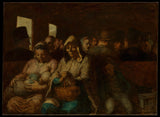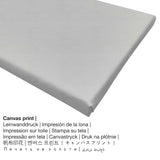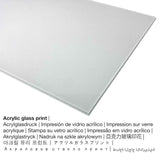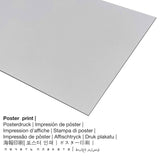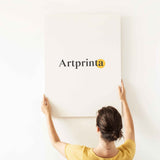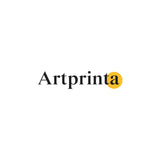Honoré Daumier, 1862 - Ụgbọ njem nke klas nke atọ - mbipụta nka mara mma
Ụtụ gụnyere. Mbupu gbakọrọ na ndenye ọpụpụ.
(© - Ụlọ ihe ngosi nka nke obodo ukwu - Museumlọ ihe ngosi nka nke Obodo)
As a graphic artist and painter, Daumier chronicled the impact of industrialization on modern urban life in mid-nineteenth-century Paris. Here, he amplifies the subject of a lithograph made some ten years earlier: the hardship and quiet fortitude of third-class railway travelers. Bathed in light, the nursing mother, elderly woman, and sleeping boy emanate a serenity not often associated with public transport. Unfinished and squared for transfer, this picture closely corresponds to a watercolor of 1864 (Walters Art Museum, Baltimore) and a roughly contemporary oil (National Gallery of Canada, Ottawa), but the sequence of the compositions remains unresolved.
Ozi ahaziri na ọrụ nka
| Aha nka: | "The Third-Class Carriage" |
| Nhazi nka: | sere |
| Otu izugbe: | nkà nke oge a |
| Narị afọ nka: | 19th narị afọ |
| Emepụtara na: | 1862 |
| Afọ nka: | gbara afọ 150 |
| Usoro nka izizi: | mmanụ na kwaaji |
| Akụkụ ihe osise izizi: | 25 3/4 x 35 1/2 na (65,4 x 90,2 cm) |
| Ụlọ ihe ngosi nka: | Museumlọ ihe ngosi nka nke Obodo |
| Ebe ngosi nka: | New York City, New York, Njikota Obodo Amerika |
| URL webụ: | www.metmuseum.org |
| Ikikere nke ihe osise: | ngalaba ọha |
| Site n'aka: | Ụlọ ihe ngosi nka nke Metropolitan, New York, HO Havemeyer mkpokọta, Arịrịọ nke Oriakụ HO Havemeyer, 1929 |
| kreditline ọrụ nka: | Mkpokọta HO Havemeyer, Arịrịọ nke Oriakụ HO Havemeyer, 1929 |
Nchịkọta nkenke nke onye na-ese ihe
| Ihe nkiri: | Sọpụrụ Daumier |
| okike onye nka: | nwoke |
| Nationality: | French |
| Ọrụ onye na-ese ihe: | onye na-ese ihe |
| Obodo onye nka: | France |
| Otu nka: | omenkà nke oge a |
| Ụdị nka: | Ihe ngosi |
| Nwụrụ anwụ: | 71 afọ |
| Afọ ọmụmụ: | 1808 |
| Ebe omuma: | Marseilles |
| Afọ nwụrụ: | 1879 |
| Nwụrụ na (ebe): | Valmondois dị nso na Paris |
Ozi ihe ahaziri ahazi
| Nkewa edemede: | ọrụ mgbidi |
| Usoro mmeghari: | dijitalụ mmeputakwa |
| Usoro nhazi: | Mbipụta UV ozugbo (mbipụta dijitalụ) |
| Mmalite nke ngwaahịa a: | Germany |
| Stockdị ngwaahịa: | mmepụta ihe na-achọ |
| Eji ngwaahịa emebere: | mkpokọta nka (mmeputakwa), nka mgbidi |
| Nhazi nka nka: | nhazi odida obodo |
| Ụdị anya: | 1.4: 1 |
| Mmetụta ihe onyonyo: | ogologo bụ 40% ogologo karịa obosara |
| Nhọrọ dị: | Mbipụta kwaaji, mbipụta enyo acrylic (nwere ezigbo mkpuchi iko), mbipụta ọla (aluminium dibond), mbipụta akwụkwọ mmado (akwụkwọ kwaaji) |
| Ọdịiche dị n'okirikiri akwa akwa akwa (akwa akwa): | 70x50cm - 28x20", 140x100cm - 55x39" |
| Mpempe iko acrylic (nwere ezigbo mkpuchi iko) nha: | 70x50cm - 28x20", 140x100cm - 55x39" |
| Mpempe akwụkwọ mmado (akwụkwọ kwaaji) nha: | 70x50cm - 28x20" |
| Nhọrọ nha nke mbipụta aluminom (aluminium dibond material) | 70x50cm - 28x20", 140x100cm - 55x39" |
| Igwe onyonyo: | agunyeghi |
Nhọrọ ihe ngwaahịa dị
Ndepụta ndetu ngwaahịa na-enye gị ohere ịhọrọ ihe na nha ọkacha mmasị gị. Họrọ n'ime nhọrọ ngwaahịa ndị a ugbu a ka ị kwekọọ na mmasị gị na nha na akụrụngwa:
- Ihe odide acrylic glass: The acrylic glass print, which is sometimes labelled as a plexiglass print, will change your favorite original work of art into home decoration and offers a viable alternative option to canvas or aluminium dibond prints. Your favorite work of art is custom-made with the help of modern UV print technology. The acrylic glass protects your selected fine art print against light and heat for many decades.
- Aluminom dibond (ọkpụkpụ ọla): An Aluminium Dibond print is a print with an impressive depth. A non-reflective surface structure make a contemporary impression. The Aluminium Dibond Print is your excellent introduction to fine art reproductions made on aluminum. The white & bright parts of the artwork shimmer with a silky gloss, however without the glow. Colors are luminous and bright, fine details of the print are crisp and clear.
- Bipụta akwụkwọ mmado n'ihe kwaaji: The poster print is a UV printed sheet of canvas with a fine structure on the surface, which reminds the original version of the artwork. Please keep in mind, that depending on the size of the poster we add a white margin of something between 2-6cm around the artwork to facilitate the framing.
- Mbipụta kanvas: The printed canvas material applied on a wood frame. A canvas makes a sculptural effect of three-dimensionality. How can I hang a canvas print on my wall? The great advantage of canvas prints is that they are relatively low in weight, meaning that it is easy and straightforward to hang up the Canvas print without extra wall-mounts. Hence, canvas prints are suited for any kind of wall.
Ihe karịrị 150 ihe nka afọ dị afọ aha ya The Third-Class Carriage e sere ya nwoke artist Honoré Daumier. The beyond 150 a na-ese ihe ochie na nha: 25 3/4 x 35 1/2 na (65,4 x 90,2 cm). Mmanụ na kwaaji was used by the painter as the medium of the painting. Moveover, the piece of art belongs to the The Metropolitan Museum of Art's digital art collection. With courtesy of - The Metropolitan Museum of Art, New York, H. O. Havemeyer Collection, Bequest of Mrs. H. O. Havemeyer, 1929 (ọha na eze). Ebe kredit nke ọrụ nka: Mkpokọta HO Havemeyer, Arịrịọ nke Oriakụ HO Havemeyer, 1929. N'elu nke ahụ, nhazi a na-abanye odida obodo format na nwere akụkụ ruru nke 1.4: 1, which means that the length is 40% longer than the width. The painter Honoré Daumier was a European artist from France, whose artistic style was primarily Realism. The painter lived for 71 afọ, born in 1808 in Marseilles and died in the year 1879 in Valmondois near Paris.
Nkwupụta iwu: We try everything to depict our art products as accurately as possible and to demonstrate them visually. Although, the colors of the print products and the print result can vary somehwat from the image on your device's screen. Depending on the screen settings and the nature of the surface, colors may not be printed one hundret percent realistically. Considering that all our fine art prints are printed and processed by hand, there may as well be minor variations in the size and exact position of the motif.
© Nwebiisinka nke, Artprinta.com

